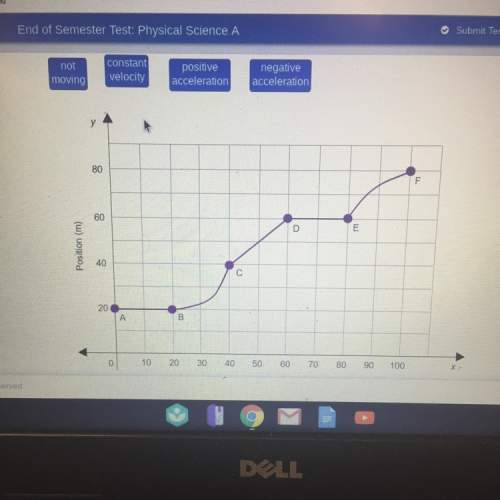
Physics, 30.01.2021 22:20 christopherwilde
Question 1 (2 points)
What state of matter is achieved if a large amount of energy is added to a gas? (2 points)
a
Vapor
b
Liquid
c
Plasma
d
Solid
Question 2 (2 points)
What happens to a gas when its temperature decreases? (2 points)
a
The gas becomes a plasma.
b
The molecules move more slowly.
c
The energy of the particles increases.
d
The atoms in the gas are destroyed.
Question 3 (2 points)
Mary and Ron are discussing what happens to the kinetic energy of molecules in a liquid as the liquid cools. Mary says it decreases. Ron says it stays the same. Who is correct and why? (2 points)
a
Mary is correct, because molecules are constantly losing kinetic energy no matter what state they are in.
b
Mary is correct, because as the liquid cools, the molecules slow down as they lose kinetic energy.
c
Ron is correct, because kinetic energy is a fixed characteristic of molecules and does not change.
d
Ron is correct, because kinetic energy can only increase, not decrease.
Question 4 (2 points)
Which quantity is directly related to the temperature of a substance? (2 points)
a
Average kinetic energy of the particles in the substance
b
Average size of the particles in the substance
c
Composition of the substance
d
pH of the substance
Question 5 (2 points)
As heat is added to a tube of gas, which is the most likely phase transition to occur in the tube? (2 points)
a
Gas to plasma
b
Gas to liquid
c
Gas to solid
d
Gas to element
Question 6 (2 points)
How do elements change as you move down a column in the periodic table? (2 points)
a
The atomic radius decreases.
b
The number of protons decreases.
c
The atomic mass decreases.
d
The electronegativity decreases.
Question 7 (2 points)
How are chemical and physical changes different on a molecular level? (2 points)
a
Chemical changes involve the breaking of bonds in molecules.
b
Chemical changes do not affect bonding between atoms.
c
Physical changes do not involve molecules.
d
Physical changes cause new molecules to form.
Question 8 (2 points)
How does the currently accepted model of the nucleus provide evidence of the existence of the strong nuclear force? (2 points)
a
The protons have like charges and should repel, so to stay near each other in the nucleus, there is a strong force holding them together.
b
The electrons have like charges and should repel each other, which is why they are scattered in the electron cloud.
c
The protons and neutrons have opposite charges and should attract each other, so to keep them apart, there must be a strong force in the nucleus.
d
The particles in the nucleus are separated by type, showing the existence of a strong force that keeps them apart.
Question 9 (2 points)
How do scientific models become stronger over time? (2 points)
a
New experiments verify or refine previous models.
b
As more people believe the model, it is stronger.
c
Older theories are always thought to be stronger than new theories.
d
Personal beliefs become more important to scientists over time.
Question 10 (2 points)
When scientists publish experimental results, their results are often criticized by other scientists. How is this process a source of strength of science? (2 points)
a
It encourages scientists to give convincing evidence for their results.
b
It allows scientists to keep their data secret.
c
A scientific model is not useful unless everyone thinks it is true.
d
It forces scientists to publish results that are in line with current theories.

Answers: 1
Another question on Physics

Physics, 22.06.2019 02:00
Transfer chemicals from one location to another to weather objects. a-water b-physical weathering c-chemical weathering
Answers: 2

Physics, 22.06.2019 06:00
Explain earth's motion, using the terms "precession" and "rotation" in your answer.
Answers: 1

Physics, 22.06.2019 07:00
If a tank filled with water contains a block and the height of the water above point a within the block is 0.8 meter, what is the pressure at point a?
Answers: 2

Physics, 22.06.2019 10:00
(a) calculate the number of electrons in a small, electrically neutral silver pin that has a mass of 10.0 g. silver has 47 electrons per atom, and its molar mass is 107.87 g/mol. (b) imagine adding electrons to the pin until the negative charge has the very large value 1.00 mc. how many electrons are added for every 109 electrons already present
Answers: 3
You know the right answer?
Question 1 (2 points)
What state of matter is achieved if a large amount of energy is added to a ga...
Questions

Mathematics, 20.05.2021 23:30

English, 20.05.2021 23:30

Law, 20.05.2021 23:30


Mathematics, 20.05.2021 23:30

Mathematics, 20.05.2021 23:30


Mathematics, 20.05.2021 23:30


Mathematics, 20.05.2021 23:30





Chemistry, 20.05.2021 23:30








